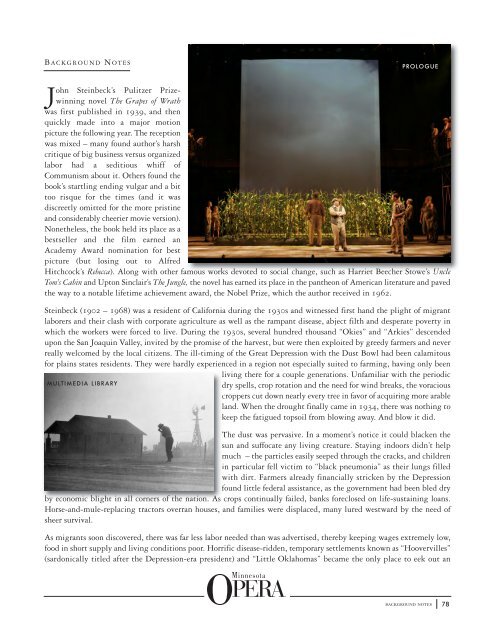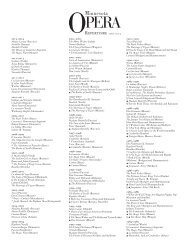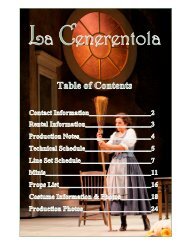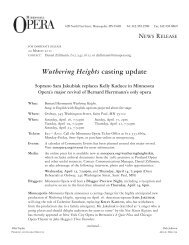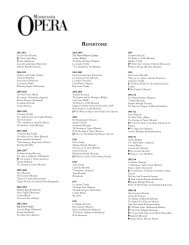You also want an ePaper? Increase the reach of your titles
YUMPU automatically turns print PDFs into web optimized ePapers that Google loves.
B A C K G R O U N D N O T E S<br />
PROLOGUE<br />
John Steinbeck’s Pulitzer Prizewinning<br />
novel The <strong>Grapes</strong> of Wrath<br />
was first published in 1939, and then<br />
quickly made into a major motion<br />
picture the following year. The reception<br />
was mixed – many found author’s harsh<br />
critique of big business versus organized<br />
labor had a seditious whiff of<br />
Communism about it. Others found the<br />
book’s startling ending vulgar and a bit<br />
too risque for the times (and it was<br />
discreetly omitted for the more pristine<br />
and considerably cheerier movie version).<br />
Nonetheless, the book held its place as a<br />
bestseller and the film earned an<br />
Academy Award nomination for best<br />
picture (but losing out to Alfred<br />
Hitchcock’s Rebecca). Along with other famous works devoted to social change, such as Harriet Beecher Stowe’s Uncle<br />
Tom’s Cabin and Upton Sinclair’s The Jungle, the novel has earned its place in the pantheon of American literature and paved<br />
the way to a notable lifetime achievement award, the Nobel Prize, which the author received in 1962.<br />
Steinbeck (1902 – 1968) was a resident of California during the 1930s and witnessed first hand the plight of migrant<br />
laborers and their clash with corporate agriculture as well as the rampant disease, abject filth and desperate poverty in<br />
which the workers were forced to live. During the 1930s, several hundred thousand “Okies” and “Arkies” descended<br />
upon the San Joaquin Valley, invited by the promise of the harvest, but were then exploited by greedy farmers and never<br />
really welcomed by the local citizens. The ill-timing of the Great Depression with the Dust Bowl had been calamitous<br />
for plains states residents. They were hardly experienced in a region not especially suited to farming, having only been<br />
living there for a couple generations. Unfamiliar with the periodic<br />
MULTIMEDIA LIBRARY<br />
dry spells, crop rotation and the need for wind breaks, the voracious<br />
croppers cut down nearly every tree in favor of acquiring more arable<br />
land. When the drought finally came in 1934, there was nothing to<br />
keep the fatigued topsoil from blowing away. And blow it did.<br />
The dust was pervasive. In a moment’s notice it could blacken the<br />
sun and suffocate any living creature. Staying indoors didn’t help<br />
much – the particles easily seeped through the cracks, and children<br />
in particular fell victim to “black pneumonia” as their lungs filled<br />
with dirt. Farmers already financially stricken by the Depression<br />
found little federal assistance, as the government had been bled dry<br />
by economic blight in all corners of the nation. As crops continually failed, banks foreclosed on life-sustaining loans.<br />
Horse-and-mule-replacing tractors overran houses, and families were displaced, many lured westward by the need of<br />
sheer survival.<br />
As migrants soon discovered, there was far less labor needed than was advertised, thereby keeping wages extremely low,<br />
food in short supply and living conditions poor. Horrific disease-ridden, temporary settlements known as “Hoovervilles”<br />
(sardonically titled after the Depression-era president) and “Little Oklahomas” became the only place to eek out an<br />
background notes<br />
78


